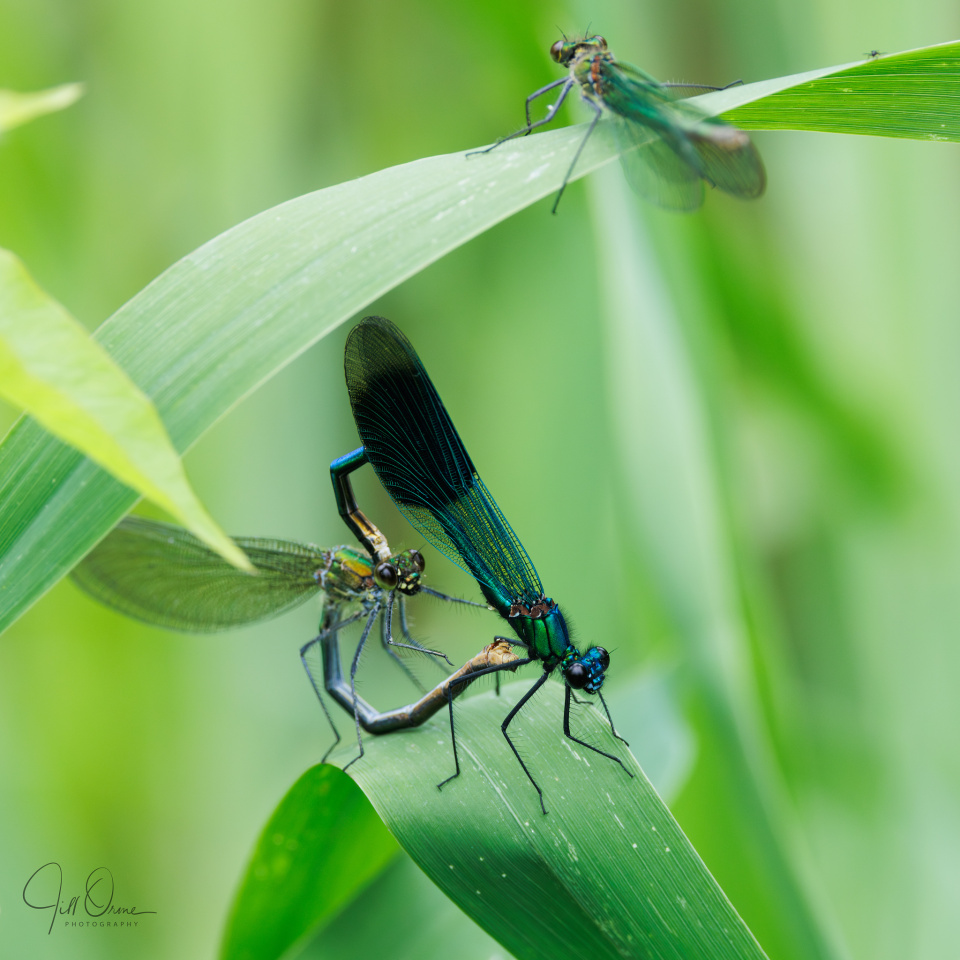While Banded Demoiselles of both sexes tend to flaunt themselves at popular breeding sites, in my experience they’re relatively secretive about the actual mating process. So while all the blue damselflies will form mating wheels very readily, and provided they’re not disturbed will hang in quite conspicuous places during copulation, I see Banded Demoiselles in cop quite infrequently.
Today I took a quick trip to the Heart of England Forest at Barton, because although the light was pretty poor I was fairly sure I’d find some kind of Odonata there, either on the riverbank or at the feeder stream. I was right, though I only managed to find three species: Banded Demoiselles, obviously, and also White-legged and Blue-tailed Damselflies.
I first noticed this pair of Banded Demoiselles through my binoculars, from the bridge that crosses the feeder stream. She wasn’t really into the idea of mating, and he had to work quite hard, and contort his own abdomen a long way, to persuade her to complete the mating wheel. Having photographed them from a distance I went round onto the stream bank above them, and began trying to spot them though the intervening foliage – knowing I’d have to work fast if I was going to get any close-ups, because mating in this species only lasts a couple of minutes. I managed to get a sight line on them just in time to rattle off a quick burst of shots, but couldn’t find an angle that allowed good focus on both partners.
This was the last frame in the sequence, taken just as the female dropped out of the wheel, but I’ve chosen it for two reasons: firstly because it has better focus on her face than the earlier frames, and secondly because it also shows the ‘spare’ female who flew in as they were mating, and positioned herself just above them. I’ve never seen this behaviour before, and I don’t know why she did it, but my guess is that she had a batch of matured eggs ready to be fertilised, and by associating herself with the copulating pair she was advertising the fact that she was also available for mating.
Once the male released her the female moved to a nearby patch of bindweed, rested for a few seconds, and then began to lay her eggs into the leaves, while he stayed on this iris leaf and observed. Once again, this oviposition behaviour was something I hadn’t seen before: Banded Demoiselle females are famous for submerging themselves completely to oviposit, breathing air that they trap between their wings as they dive, and I’d never seen one use bankside vegetation for laying. According to Mike Siva Jothy in my Bloomsbury Field Guide they’re relatively unfussy about the oviposition substrates they choose, and will use a range of emergent as well as submerged vegetation, but the bindweed that this female chose was a good six feet above the stream, which I’d hardly call ’emergent’. However, she looks quite old, and I guess her casual attitude to oviposition might reflect her age, and the reluctance she’d shown to copulate in the first place.
Perhaps the male would have done better to choose her rival, who looks equally old, but probably more willing.
R: C4.







